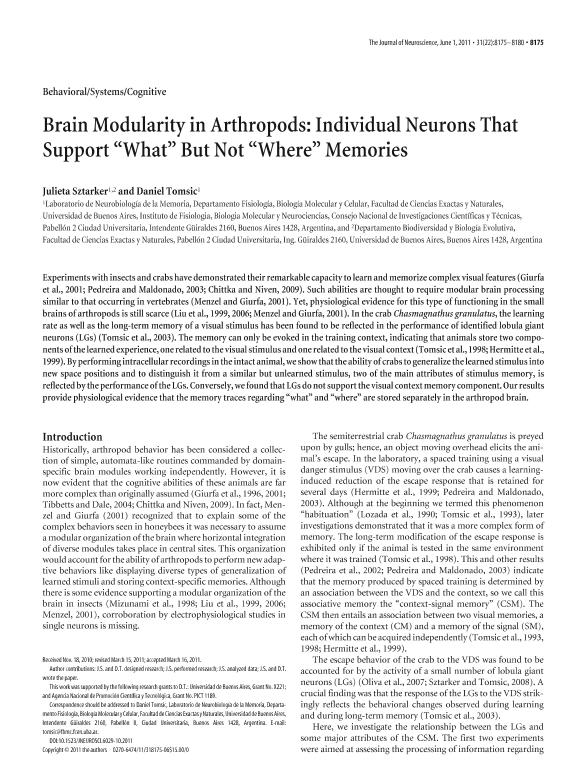Mostrar el registro sencillo del ítem
dc.contributor.author
Sztarker, Julieta

dc.contributor.author
Tomsic, Daniel

dc.date.available
2017-07-13T15:16:39Z
dc.date.issued
2011-06
dc.identifier.citation
Sztarker, Julieta; Tomsic, Daniel; Brain modularity in arthropods: individual neurons that support “what” but not “where” memories; Society for Neuroscience; Journal of Neuroscience; 31; 22; 6-2011; 8175-8180
dc.identifier.issn
0270-6474
dc.identifier.uri
http://hdl.handle.net/11336/20336
dc.description.abstract
Experiments with insects and crabs have demonstrated their remarkable capacity to learn and memorize complex visual features (Giurfa et al., 2001; Pedreira and Maldonado, 2003; Chittka and Niven, 2009). Such abilities are thought to require modular brain processing similar to that occurring in vertebrates (Menzel and Giurfa, 2001). Yet, physiological evidence for this type of functioning in the small brains of arthropods is still scarce (Liu et al., 1999, 2006; Menzel and Giurfa, 2001). In the crab Chasmagnathus granulatus, the learning rate as well as the long-term memory of a visual stimulus has been found to be reflected in the performance of identified lobula giant neurons (LGs) (Tomsic et al., 2003). The memory can only be evoked in the training context, indicating that animals store two components ofthe learned experience, one relatedtothe visual stimulus and one relatedtothe visual context (Tomsic et al., 1998; Hermitte et al., 1999). By performing intracellular recordings inthe intact animal, we showthatthe ability of crabsto generalizethe learned stimulus into new space positions and to distinguish it from a similar but unlearned stimulus, two of the main attributes of stimulus memory, is reflected bythe performance ofthe LGs. Conversely, wefoundthat LGs do not supportthe visual context memory component. Our results provide physiological evidence that the memory traces regarding “what” and “where” are stored separately in the arthropod brain.
dc.format
application/pdf
dc.language.iso
eng
dc.publisher
Society for Neuroscience

dc.rights
info:eu-repo/semantics/openAccess
dc.rights.uri
https://creativecommons.org/licenses/by-nc-sa/2.5/ar/
dc.subject
Learning
dc.subject
Generalization
dc.subject
Escape Response
dc.subject
Intracellular Recordings
dc.subject.classification
Otras Ciencias Biológicas

dc.subject.classification
Ciencias Biológicas

dc.subject.classification
CIENCIAS NATURALES Y EXACTAS

dc.title
Brain modularity in arthropods: individual neurons that support “what” but not “where” memories
dc.type
info:eu-repo/semantics/article
dc.type
info:ar-repo/semantics/artículo
dc.type
info:eu-repo/semantics/publishedVersion
dc.date.updated
2017-07-12T14:52:46Z
dc.identifier.eissn
1529-2401
dc.journal.volume
31
dc.journal.number
22
dc.journal.pagination
8175-8180
dc.journal.pais
Estados Unidos

dc.journal.ciudad
Washington DC
dc.description.fil
Fil: Sztarker, Julieta. Consejo Nacional de Investigaciones Científicas y Técnicas. Oficina de Coordinación Administrativa Ciudad Universitaria. Instituto de Fisiología, Biología Molecular y Neurociencias. Universidad de Buenos Aires. Facultad de Ciencias Exactas y Naturales. Instituto de Fisiología, Biología Molecular y Neurociencias; Argentina
dc.description.fil
Fil: Tomsic, Daniel. Consejo Nacional de Investigaciones Científicas y Técnicas. Oficina de Coordinación Administrativa Ciudad Universitaria. Instituto de Fisiología, Biología Molecular y Neurociencias. Universidad de Buenos Aires. Facultad de Ciencias Exactas y Naturales. Instituto de Fisiología, Biología Molecular y Neurociencias; Argentina
dc.journal.title
Journal of Neuroscience

dc.relation.alternativeid
info:eu-repo/semantics/altIdentifier/doi/http://dx.doi.org/10.1523/JNEUROSCI.6029-10.2011
dc.relation.alternativeid
info:eu-repo/semantics/altIdentifier/url/http://www.jneurosci.org/content/31/22/8175
Archivos asociados
